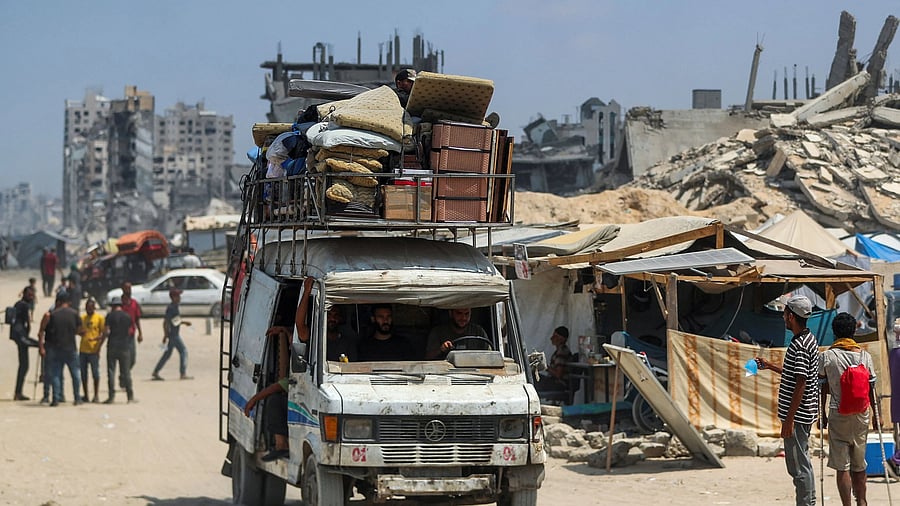
Displaced Palestinians fleeing northern Gaza travel in a vehicle loaded with their belongings while they head south as the Israeli military prepares to relocate residents to the southern part of the enclave, in Gaza City, August 18, 2025.
Credit: Reuters Photo
Cairo: Fearing an imminent Israeli ground offensive, thousands of Palestinians have left their homes in eastern areas of Gaza City, now under constant Israeli bombardment, for points to the west and south in the shattered territory.
Israel's plan to seize control of Gaza City has stirred alarm abroad and at home where tens of thousands of Israelis held some of the largest protests since the war began, urging a deal to end the fighting and free the remaining 50 hostages held by Palestinian militants in Gaza since October 7, 2023.
The planned offensive has spurred Egyptian and Qatari ceasefire mediators to step up efforts in what a source familiar with the talks with Hamas militants in Cairo said could be "the last-ditch attempt."
Israeli Prime Minister Benjamin Netanyahu has described Gaza City as Hamas' last big urban bastion. But, with Israel already holding 75% of Gaza, the military has warned that expanding the offensive could endanger hostages still alive and draw troops into protracted and deadly guerrilla warfare.
Dani Miran, whose son Omri was taken hostage on October 7, said he fears the consequences of an Israeli ground offensive in Gaza City. "I'm scared that my son would be hurt," he said in a Reuters interview in Tel Aviv on Monday.
In Gaza City, many Palestinians have also been calling for protests soon to demand an end to a war that has demolished much of the territory and wrought a humanitarian disaster, and for Hamas to intensify talks to avert the Israeli ground offensive.
An Israeli armoured incursion into Gaza City could displace hundreds of thousands of people, many of whom have been uprooted multiple times during the war.
Ahmed Mheisen, Palestinian shelter manager in Beit Lahiya, a war-devastated suburb abutting eastern Gaza City, said 995 families had departed the area in recent days for the south.
With the Israeli offensive looming, Mheisen put the number of tents needed for emergency shelter at 1.5 million, saying Israel had allowed only 120,000 tents into the territory during a January-March ceasefire.
The U.N. humanitarian office said last week 1.35 million people were already in need of emergency shelter items in Gaza.
"The people of Gaza City are like someone who received a death sentence and is awaiting execution," said Tamer Burai, a Gaza City businessman.
"I am moving my parents and my family to the south today or tomorrow. I can't risk losing any of them should there be a surprising invasion," he told Reuters via a chat app.
A protest by unions is scheduled for Thursday in Gaza City, and people took to social media platforms vowing to participate, which will raise pressure on Hamas.
The last round of indirect ceasefire talks ended in late July in deadlock with the sides trading blame for its collapse.
Sources close to the Cairo talks said Egyptian and Qatari mediators had met with leaders of Hamas, allied militant group Islamic Jihad and other factions with little progress reported.
Hamas told mediators it was ready to resume talks about a U.S.-proposed 60-day truce and release of half the hostages, one official, who asked not to be named, told Reuters, but also for a wider deal that would end the war.
Diplomatic deadlock
Israel says it will agree to cease hostilities if all the hostages are released and Hamas lays down its arms - the latter demand publicly rejected by the Islamist group until a Palestinian state is established.
A Hamas official told Reuters on Monday the group rejects Israeli demands to disarm or expel its leaders from Gaza.
Sharp differences also appear to remain over the extent of an Israeli withdrawal from Gaza and how humanitarian aid will be delivered around the enclave, where malnutrition is rife and aid groups warn of unfolding famine.
Underscoring the gaps in talks on a ceasefire, U.S. President Donald Trump wrote on his social media platform on Monday: "We will only see the return of the remaining hostages when Hamas is confronted and destroyed!!! The sooner this takes place, the better the chances of success will be."
On Saturday, the Israeli military said it was preparing to help equip Gazans with tents and other shelter equipment ahead of relocating them from combat zones to the south of the enclave. It did not provide further details on quantities or how long it would take to get the equipment into the enclave.
"Existing tents where people are living (in the south) have worn out and won't protect people against rainwater. There are no new tents in Gaza because of the Israeli restrictions on aid at the border crossings," Palestinian economist Mohammad Abu Jayyab told Reuters.
He said some Gaza City families had begun renting property and shelters in the south and moved in their belongings.
"Some people learned from previous experience, and they don't want to be taken by surprise. Also, some think it is better to move earlier to find a space," Abu Jayyab added.
The war began when Hamas-led militants stormed across the border into southern Israel, killing 1,200 people and taking 251 hostages back to Gaza, according to Israeli tallies.
More than 61,000 Palestinians have since been killed in Israel's ensuing air and ground war in Gaza, according to local health officials who do not distinguish between fighters and non-combatants.
Five more Palestinians have died of malnutrition and starvation in the past 24 hours, the Gaza health ministry said on Monday, raising the number of people who died of those causes to 263, including 112 children, since the war started.
Israel disputed the figures provided by the health ministry in the Hamas-run territory.